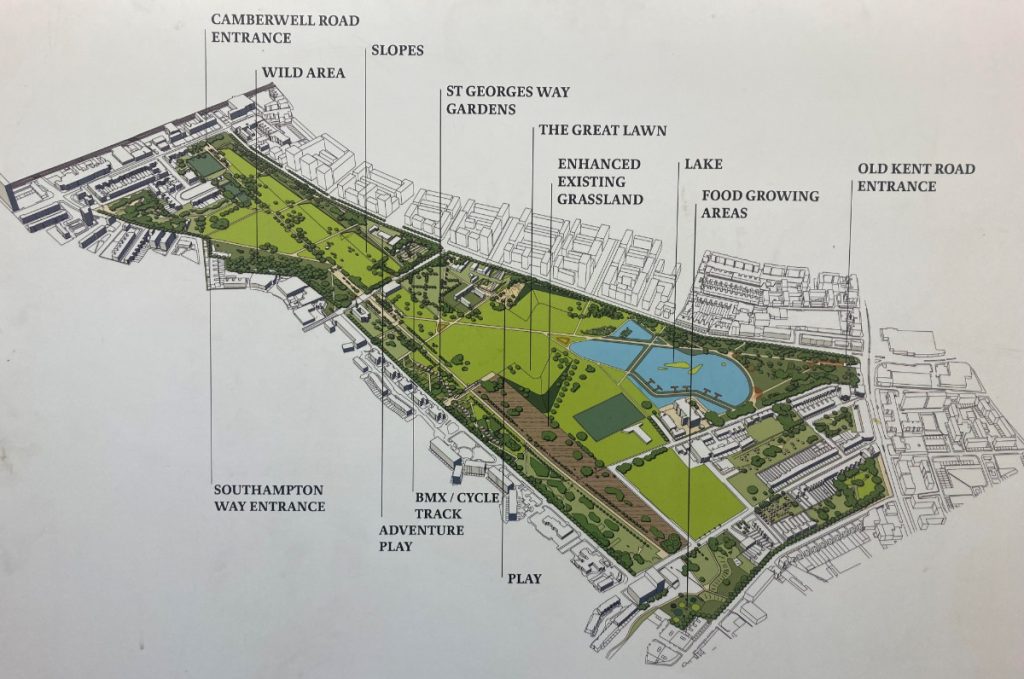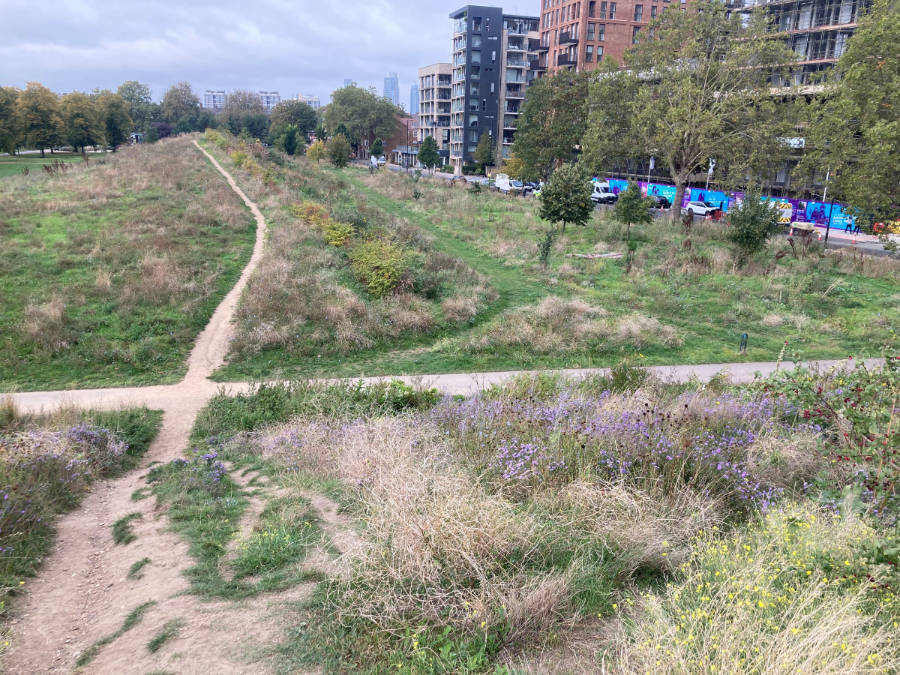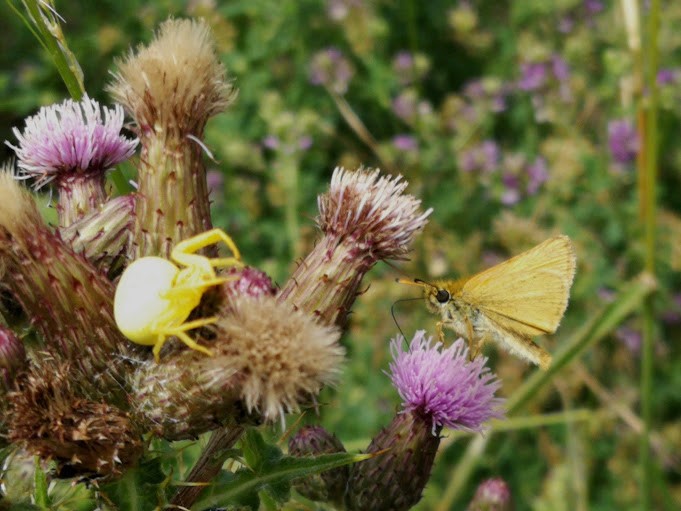A wildlife-friendly approach to Burgess Park maintenance

Burgess Park is a large, 24-hour, much frequented green space built in stages over what was previously dense housing and industrial land to eventually become the park we know today. As a result, the soil is difficult to cultivate, with, in many places, the history of the past thinly concealed beneath a layer of compacted topsoil. At around the turn of this century, the space was redesigned and the new park grown on top, but with much of the same soil below.
The redesigned park1 has become a functioning tapestry of recreational space and wilder areas, short and long grass, redefined or new woodlands and lots of other new planting. This includes the famous James Hitchmough2 being tasked with designing large non-native prairies to interlink with the improved meadows and wilder areas. He worked with the park gardeners to create the beautiful St George’s prairie, and experimented with non-native mass plantings in various other areas with the LDA contractors. The redesign was very wildlife-aware, and had a looser, more modern approach compared to the typical short grass, flowerbeds and trees combination of many urban green spaces, though we have these things too. There was a mixture of native and many new interesting plants in meadows, and on many new mounds and slopes and dips across the park.

Over the last two and a bit decades the park has aged, and this ambitious planting has matured and either sustained itself or faded, with nature often having a greater say on the appropriate balance of wildness or cultivation than the gardeners. St George’s has established well, though it is a little tatty these days, with native grasses joining the party and plenty of brambles and tree suckers to remove, invasive native plants taking over in places and gaps appearing in the planting under all the large trees. But a beautiful and clever prairie planting of mainly American perennials that flower in a succession from spring until frost has sustained itself over time. Other Hitchmough areas have persisted well, semi-lasted or faded into wildness, with the wildlife benefiting from our aesthetic loss. We have continued to maintain these areas in some way too, or redefine them in some way as habitat.
It is interesting to observe the relationship between plants that grow naturally and what is planted by humans: how this influences the ecology of the space (how much wildlife is present), and how this will change with the weather over time. Burgess is a great place to do this, with the multitude of different meadows, slopes, dips and flowerbeds all with their own balance of wildness to cultivation. Some of these areas we maintain intensively and others have been left to grow as wild as possible, and most areas are somewhere in between, with a mixture of introduced plants growing happily alongside those appearing naturally. And beyond this intended planting or sowing there is also the turf itself, which is not just grass but potentially a whole range of other wild plants, either growing away happily in the lawn, or in seeds waiting to germinate.
So as the gardeners we maintain these mixed plant populations and try to make them attractive to humans as well as useful for wildlife. There are many questions we can ask to try and do this. These could include:
- What is the best balance of native and cultivated plants?
- What should we weed out or keep?
- Which flowers are useful to pollinating insects?
- Can non-native plants significantly lengthen the flowering season?
- How can we best maintain the meadows, to maximise flowering and wildlife potential?
- How can we best cut the short grass to provide more wildflowers?
- How can we best manage the woodlands and wetlands for more habitat?
- How sustainable is the park as a habitat and food source for wildlife, and for us?
- How will the planting at Burgess evolve over time with people pressure and climate change?

Burgess Park’s wildlife potential is limited by its location in the centre of a city, surrounded by tall buildings and busy roads. Increasingly tall buildings around the park will also increasingly block off wildlife from making it here. The park is also potentially full of people on a sunny day, and can be very busy and noisy. The soil is compacted and full of rubble and potentially toxic chemicals. We are in the centre of London, where it is hot and dry, with not enough rain. So there are many factors that limit the amount of wildlife visiting or living at the park.
But despite the location and other limiting factors, we are doing pretty well in comparison to many green spaces … with the butterfly / bird and bug experts reporting back positively on their findings here. (If you are interested in surveying this wildlife, join one of the Butterfly Conservation transect walks, or connect with local bird spotting and other wildlife experts online). It is fantastic to hear that we have any wildlife at all on our slice of urban land far from the country.

But generally there is a noticeable and worrying decline in wildlife, with fewer insects, bees and birds apparent each year. There has been an obvious decline in insect life especially, which has a knock-on effect on the creatures that feed on them, such as birds. This has been especially apparent after the sequence of worryingly hot summers. Meadows and wild areas formerly buzzing with life now seem to have much lower populations of insects.
So it’s really important that we do what we can to provide as much habitat for wild creatures to enable them to survive in our park and to try to sustain the tree of life that ultimately sustains us.
So what can we do as gardeners in the park to create a more diverse and wildlife friendly space?
Gardening is a strange pursuit. We generally dig up all the wildness and native plants, and replace them with neat and cultivated plants, often from elsewhere in the world. But local flora has evolved to sustain local fauna, and many animals depend on specific plants for survival.
The longer I am a gardener and environmentalist, the more I’m interested in what grows naturally, as well as which human-planted or sown, native or non-native plants can be added in order to create more diversity, food sources and habitat for wildlife. Going back to James Hitchmough’s large scale non-native sowing and planting: what is perhaps most interesting is which of these plants will persist in our space over time, merging with our native plants and continuing to grow. Will they sustain themselves or even spread into the surrounding space? In a wildlife context, of course, we have to be careful not to introduce invasive species that will outgrow our local plants, but could we add some non-local native plants and non-natives to wilder areas, to supercharge nature by creating more habitat and food, especially as the climate changes and our range of balance of native plants adjusts anyway? Could we make our wildness more beautiful and diverse again instead of letting it fade? Where do the best plants to try to introduce come from, in terms of having similar soil and climate conditions?
We are trying to find a successful balance between cultivation and wildness that maximises the park’s ecological potential. If we do introduce non-native plants it’s important that they are good for wildlife too.
So what more can we do? We have meadows and prairies and woodlands, plenty of wild areas in the park. But there is one type of planting, and the biggest area of all, with the most potential to grow more wild plants: the short grass areas or lawns.
In amongst the grass species regularly cut to grow thick and low, to create a green (or often these days more parched and yellow) lawn, are a whole multitude of other wild plants growing away secretly amongst the grass. These ‘lawn weeds’ are smaller broad-leafed plants that can tolerate being mown regularly (in our park about once a month). And there is also seed waiting in the soil below the grass from times past, waiting for an opportunity to germinate. Some seed can remain dormant for great periods. So what viable ecological history and diversity is there still hidden under our lawns? If we let the grass grow longer than usual, some of these plants will say hello with their flowers. So hidden underneath this turf monoculture is all of nature’s remaining wildness and potential to sustain itself.
It is very important that with the destruction of wildness and colony collapse of so many species we make use of this potential to sustain some more wildlife.
Leaving lawns to grow long and provide habitat and flowers for wildlife is very topical, with so much concern about wildlife and habitat loss. On social media are endless images of impossibly beautiful meadows alongside neat cut lawns comparing the two, with uncut grass being good and lawns being bad. Anyone on a mower is basically the devil.
But rather than cutting being evil and not cutting being good, some kind of cutting has to happen. Nearly all green space is managed. A lawn if left uncut will become a meadow. Over time it will thicken up, and the range of species will change. Shrubs and trees will germinate and grow. Slowly the meadow will become a copse, and then a woodland, then eventually a thick forest. The grass needs to be cut to still be a meadow. The question is: when and how frequently, and with what equipment, to maximise its wildlife value?
So most meadows are actually extensively managed spaces with some kind of maintenance regime, or they wouldn’t be meadows for very long, and many wildflowers benefit from this cycle of cutting and ploughing. I wish we had things like ploughs at the park! Going back in time, the UK had a huge amount of these meadows, wheat and hay fields and foraging meadows, without the use of chemicals to control what grows. Most of these have now been replaced with modern agriculture, with mono-culture and chemical spraying, and most of the wildflowers have gone.
With these traditional meadows gone, we rely on the remainder of our green space and wild places to sustain the diversity of the wildlife that used to live in the old meadows. And much of the recreational green space in the UK is unimaginatively cut short grass and little else. But there is so much wildlife potential hiding beneath these tidy English lawns. We just have to let some of them grow.

There are hundreds of acres of such grass at Burgess, and we still have to cut a lot of it regularly enough to stay a lawn. Contractually we are obliged to do so at a certain frequency. The park is for people and recreation, not just wildlife. People want short grass to comfortably sit, picnic or sunbathe, exercise, play sports, walk pets. The short grass areas are also useful for larger events and festivals. The park also needs to be easily accessible, and it also needs to be open enough to be safe to walk through, especially considering that Burgess is a 24-hour space.
We can have both recreational lawns and plentiful habitat for wildlife too, but we need to ask many questions about how we cut the grass.
- Beyond the more clearly defined meadow areas what else can we do to encourage more wildflowers and wildlife?
- How much short grass does there need to be to keep people happy and the park safe?
- Does every last blade of grass need cutting regularly or can a more loose and dynamic approach be taken?
- How often does the grass need cutting to keep it under control?
- How easy is it to cut the grass short again if we temporarily let it grow long?
- Do cuttings need collecting and reusing somehow, or can they be left in situ; and how does this affect the soil and more plants growing?
- How messy do different approaches look? Can we tolerate a bit of hay for the sake of wildlife?
- Does leaving grass to grow long create other problems, with more litter, toileting and more anti-social behaviour?
- Can the grass-cutting regime be changed but still be understandable and realistically achievable for the grass cutters?
- Do we have the machinery that can cope with cutting and potentially clearing longer grass areas?
- How are the plants that appear affected by location, the soil and environmental conditions?
- Most importantly, once we cut the grass at lower frequencies, what different wild plants appear and what wildlife do they attract?
So we have left many areas to experiment. This year we:
- Continued to experiment with encouraging wildflowers along Albany Road in the west side of the park, after creating a large new meadow between the mounds and the road (there was previously just short grass). This has involved various re-seeding, and cutting and collecting at different times, with different amounts of hay-raking.
- Continued to leave various other previous short areas of grass un-mown or mown at different frequencies to see what wildflowers appeared. These areas included:
- The grass all the way around the car park
- A large triangle of grass opposite St George’s church
- The steep slopes next to the BMX track
- Areas of previously cut grass around the tennis court cafe
- The complete south-facing bank of the great lawn
- Much larger meadow patches at Rust Square
We also:
- Were slower to cut the grass in April/May — cutting as little as possible or leaving large areas uncut
- Cut around significant patches of wildflowers when we found them throughout the season
- Experimented with hay: can it be turned into a rough ‘strulch’ for flowerbeds or used as a mulch around trees?
- Observed the changing ratios of plants, native and non-native, in all of our more permanent longer grass, meadow areas, prairies, hollows and banks
The basic conclusions made from of all this grass-cutting experimentation are interesting, and, I think, show that:
- Experimenting with grass-cutting heights, frequencies and techniques with the typical range of equipment and staff available is perfectly achievable in most green spaces with a bit of thought and a more dynamic approach
- There is a fear that if we don’t keep the grass cut short and regular everything will grow out of control; there will be chaos instead of order and then the world will likely end! This is far from true. Grass can easily be left to grow longer, so the wild plants can flower and seed, and then be cut short again when appropriate with suitably powerful mowers or other better suited equipment such as scythes and flails if available

Making our lawns more wildlife friendly is perfectly achievable with a bit of thought and a ripping up of old grounds-maintenance contracts that specify that all grass must be cut low.
With a more multi-layered approach to grass cutting all kinds of wild plants can appear. The lawns can cease to be dead zones for nature and become useful habitats. These useful habitats will link all the intentional planting in the park to create a more complete ecology.
But in many places longer grass is inappropriate, or the resulting meadow not impressive-looking to us or floriferous for wildlife. Wildness can cause other problems with rubbish and questionable human behaviour! A lot depends on the site: how it is used by people, the presence of the right conditions for specific plants to grow, and whether those wild plants are still there in the first place, having been reduced to short lawns for so long.
In the next blog I’d like to discuss these meadow experiments in more detail and how successful they have been, as well as suggesting the best practice for cutting meadows and an updated approach for short-grass cutting that we have started using in small areas of the park already.
Gregory Smith
Head Gardener, Burgess Park
1 Landscape Institute case study, LDA Design Consulting LTD, Burgess Park Regeneration Project
https://my.landscapeinstitute.org/case-study/burgess-park-regeneration-project/0a156c22-d37b-e911-a99b-00224801ab04
2 The Landscape Institute, The Landscape Legacy of the Olympics, Part 7, The Olympic Planting Strategy, Olympic Park designers Professors Hitchmough and Dunnett interviewed
http://www.youtube.com/watch?v=YsuU3APsA5c
REF 2014 impact case studies — The development of new, designed sustainable plant communities for use in urban greenspace
https://impact.ref.ac.uk/casestudies/CaseStudy.aspx?Id=23133










